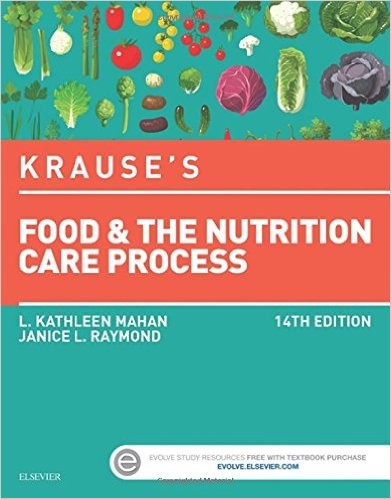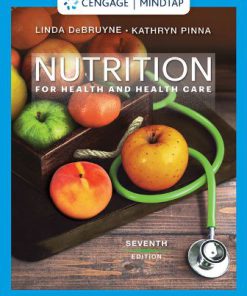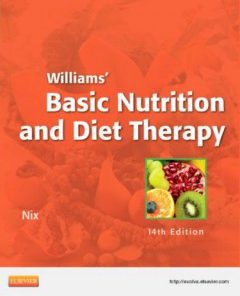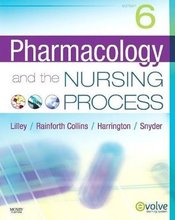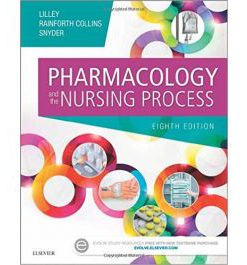Test Bank for Krauses Food and the Nutrition Care Process 14th Edition by Mahan
$35.00 Original price was: $35.00.$26.50Current price is: $26.50.
Test Bank for Krauses Food and the Nutrition Care Process 14th Edition by Mahan
This is completed downloadable of Test Bank for Krauses Food and the Nutrition Care Process 14th Edition by Mahan
Product Details:
- ISBN-10 : 9780323340755
- ISBN-13 : 978-0323340755
- Author: By L. Kathleen Mahan
A trusted classic for over 50 years, Krause’s Food and the Nutrition Care Process, 14th Edition presents the most cutting-edge and up-to-date dietetics content available in this ever-changing field. Nicknamed the “nutrition bible”, students and practitioners alike turn to its current, comprehensive content, engaging pedagogy and design, and logical presentation of information. This new edition includes the 2015 Dietary Guidelines for Americans, more visuals, and highlighted Clinical Case Studies, Clinical Insights, and Clinical Applications boxes that help translate scientific knowledge into practical patient care. Written by nearly 50 nationally recognized writers, researchers, and practitioners, it covers nutrition assessment and intervention, the nutritional needs of individuals in different stages of the life cycle, nutrition for health and fitness, and medical nutrition therapy.
Table of Content:
- Acknowledgments
- 1. Nutrition Assessment
- Introduction
- 1. Intake: Digestion, absorption, transport, and excretion of nutrients
- The gastrointestinal tract
- Brief overview of digestive and absorptive processes
- The small intestine: Primary site of nutrient absorption
- The large intestine
- Useful websites
- References
- 2. Intake: Energy
- Energy requirements
- Components of energy expenditure
- Estimating energy requirements
- Calculating food energy
- Useful websites/apps
- References
- 3. Inflammation and the pathophysiology of chronic disease
- Epidemic of chronic disease
- Concepts of chronic disease pathophysiology
- Inflammation: Common denominator of chronic disease
- Nutrient modulators of inflammation
- Reducing inflammation in the body
- Prolonged inflammation expression specific to major chronic diseases
- Summary
- Useful websites
- References
- 4. Intake: Analysis of the diet
- Nutrition screening
- Nutrition assessment
- Analysis of dietary intake data
- Useful websites
- References
- 5. Clinical: Nutritional genomics
- The human genome project and the “OMIC” disciplines
- Genotype and nutrition assessment
- Genetic fundamentals
- Genetics and nutrition therapy
- Ethical, legal, and social implications
- Summary
- Useful websites
- References
- 6. Clinical: Water, electrolytes, and acid-base balance
- Body water
- Electrolytes
- Acid-base balance
- Acid-base disorders
- Useful websites, tools/calculators, and apps
- References
- 7. Clinical: Biochemical, physical, and functional assessment
- Biochemical assessment of nutrition status
- Nutrition interpretation of routine medical laboratory tests
- Assessment of hydration status
- Assessment for nutritional anemias
- Fat-soluble vitamins
- Water-soluble vitamins and trace minerals
- Chronic disease risk assessment
- Physical assessments
- Nutrition-focused physical assessment
- Useful websites
- References
- 8. Clinical: Food-drug interactions
- Pharmacologic aspects of food-drug interactions
- Risk factors for food-drug interactions
- Effects of food on drug therapy
- Medication and enteral nutrition interactions
- Effects of drugs on food and nutrition
- Modification of drug action by food and nutrients
- Effects of drugs on nutrition status
- Excipients and food-drug interactions
- Medical nutrition therapy
- Useful websites
- References
- 9. Behavioral-environmental: The individual in the community
- Social determinants of health
- Nutrition practice in the community
- Needs assessment for community-based nutrition services
- National nutrition surveys
- National nutrition guidelines and goals
- Food assistance and nutrition programs
- Foodborne illness
- Food and water safety
- Disaster planning
- Healthy food and water systems and sustainability
- Summary: A work in progress
- Useful websites
- References
- 2. Nutrition Diagnosis and Intervention
- Introduction
- 10. Overview of nutrition diagnosis and intervention
- The nutrition care process
- Documentation in the nutrition care record
- Influences on nutrition and health care
- Nutrition interventions
- Nutrition for the terminally ill or hospice patient
- Useful websites
- References
- 11. Food and nutrient delivery: Diet guidelines, nutrient standards, and cultural competence
- Determining nutrient needs
- Worldwide guidelines
- Nutritional status of Americans
- National guidelines for diet planning
- Food and nutrient labeling
- Dietary patterns and counseling tips
- Cultural aspects of dietary planning
- Useful websites
- References
- 12. Food and nutrient delivery: Complementary and integrative medicine and dietary supplementation
- Complementary and integrative medicine
- Use of complementary and integrative therapies
- Dietary supplementation
- Dietary supplement regulation
- Assessment of dietary supplement use in patients
- Useful websites
- References
- 13. Food and nutrient delivery: Nutrition support 1
- Rationale and criteria for appropriate nutrition support
- Enteral nutrition
- Enteral nutrition access
- Parenteral nutrition
- Complications
- Refeeding syndrome
- Transitional feeding
- Nutrition support in long-term and home care
- Useful websites
- References
- 14. Education and counseling: Behavioral change
- Behavior change
- Models for behavior change
- Models for counseling strategies
- Models for educational program development
- Skills and attributes of the nutrition educator or counselor
- Assessment results: Choosing focus areas
- Counseling approaches after the assessment
- Unsure-about-change counseling sessions
- Resistance behaviors and strategies to modify them
- Ready-to-change counseling sessions
- Evaluation of effectiveness
- Summary
- Useful websites
- References
- 3. Nutrition in the Life Cycle
- Introduction
- 15. Nutrition for reproductive health and lactation
- Preconception and fertility
- Conception
- Pregnancy
- Postpartum period = preconceptual period
- Lactation
- Useful websites
- References
- 16. Nutrition in infancy
- Physiologic development
- Nutrient requirements
- Milk
- Food
- Feeding
- Useful websites
- References
- 17. Nutrition in childhood
- Growth and development
- Nutrient requirements
- Providing an adequate diet
- Nutritional concerns
- Preventing chronic disease
- Useful websites
- References
- 18. Nutrition in adolescence
- Growth and development
- Nutrient requirements
- Food habits and eating behaviors
- Nutrition screening, assessment, and counseling
- Special concerns
- Useful websites
- References
- 19. Nutrition in the adult years
- Setting the stage: Nutrition in the adult years
- Setting the stage: Messages
- Information sources
- Lifestyle health risk factors
- Health disparities and access to care
- Interventions, nutrition, and prevention
- Food trends and patterns
- Nutritional supplementation
- Functional foods
- Healthy food and water systems and sustainability
- Adult health next steps
- Useful websites
- References
- 20. Nutrition in aging
- The older population
- Gerontology + geriatrics = the spectrum of aging
- Nutrition in health promotion and disease prevention
- Theories on aging
- Physiologic changes
- Quality of life
- Nutrition screening and assessment
- Nutrition needs
- Medicare benefits
- Nutrition support services
- Community and residential facilities for older adults
- Useful websites
- References
- 4. Nutrition for Health and Fitness
- Introduction
- 21. Nutrition in weight management
- Body weight components
- Regulation of body weight
- Weight imbalance: Overweight and obesity
- Management of obesity in adults
- Common problems in obesity treatment
- Weight management in children and adolescents
- Weight imbalance: Excessive leanness or unintentional weight loss
- Useful websites
- References
- 22. Nutrition in eating disorders
- Clinical characteristics and medical complications
- Treatment approach
- Psychologic management
- Nutrition management
- Medical nutrition therapy and counseling
- Useful websites
- References
- 23. Nutrition in exercise and sports performance
- An integrative approach to working with athletes
- Bioenergetics of physical activity
- Fuels for contracting muscles
- Nutritional requirements of exercise
- Weight management
- Weight management and aesthetics
- Macronutrients
- Carbohydrate
- Protein
- Fat
- Fluid
- Other considerations
- Vitamins and minerals
- Minerals
- Ergogenic aids
- Ergogenic aids for high intensity exercise
- Herbs
- Performance enhancement substances and drugs (PES/PED): Doping in sport
- Useful websites
- References
- 24. Nutrition and bone health
- Bone structure and bone physiology
- Osteopenia and osteoporosis
- Diagnosis and monitoring
- Nutrition and bone
- Prevention of osteoporosis and fractures
- Treatment of osteoporosis
- Useful websites
- References
- 25. Nutrition for oral and dental health
- Nutrition for tooth development
- Dental caries
- Early childhood caries
- Caries prevention
- Tooth loss and dentures
- Other oral disorders
- Periodontal disease
- Oral manifestations of systemic disease
- Useful websites
- References
- 5. Medical Nutrition Therapy
- Introduction
- 26. Medical nutrition therapy for adverse reactions to food: Allergies and intolerances
- Definitions
- Etiology
- Pathophysiology
- Food intolerances
- Assessment
- Medical nutrition therapy
- Emerging therapies
- Preventing food allergy
- Useful websites and apps
- References
- 27. Medical nutrition therapy for upper gastrointestinal tract disorders
- Assessment parameters
- The esophagus
- The stomach
- Gastroparesis
- Useful websites
- References
- 28. Medical nutrition therapy for lower gastrointestinal tract disorders
- Common intestinal problems
- Diseases of the small intestine
- Intestinal brush-border enzyme deficiencies
- Inflammatory bowel diseases
- Nutritional consequences of intestinal surgery
- Useful websites
- References
- 29. Medical nutrition therapy for hepatobiliary and pancreatic disorders
- Physiology and functions of the liver
- Diseases of the liver
- Complications of ESLD: Cause and nutrition treatment
- Nutrition issues related to end-stage liver disease
- Nutrient requirements for cirrhosis
- Herbal supplements and liver disease
- Liver resection and transplantation
- Physiology and functions of the gallbladder
- Diseases of the gallbladder
- Complementary and integrative medicine
- Physiology and functions of the exocrine pancreas
- Diseases of the exocrine pancreas
- Complementary and integrative medicine
- Pancreatic surgery
- Useful websites
- References
- 30. Medical nutrition therapy for diabetes mellitus and hypoglycemia of nondiabetic origin
- Incidence and prevalence
- Categories of glucose intolerance
- Screening and diagnostic criteria
- Management of prediabetes
- Management of diabetes
- Implementing the nutrition care process
- Acute complications
- Long-term complications
- Hypoglycemia of nondiabetic origin
- Useful websites
- References
- 31. Medical nutrition therapy for thyroid, adrenal, and other endocrine disorders
- Thyroid physiology
- Assessment in thyroid disorders
- Hypothyroidism
- Polycystic ovary syndrome
- Hyperthyroidism
- Managing imbalances of the hypothalamus-pituitary-thyroid axis
- Adrenal disorders
- Useful websites
- References
- 32. Medical nutrition therapy for anemia
- Iron-related blood disorders
- Iron overload
- Megaloblastic anemias
- Other nutritional anemias
- Nonnutritional anemias
- Useful websites
- References
- 33. Medical nutrition therapy for cardiovascular disease
- Atherosclerosis and coronary heart disease
- Genetic hyperlipidemias
- Hypertension
- Heart failure
- Cardiac transplantation
- Useful websites
- References
- 34. Medical nutrition therapy for pulmonary disease
- The pulmonary system
- Chronic pulmonary disease
- Asthma
- Chronic obstructive pulmonary disease
- Tuberculosis
- Lung cancer
- Obesity hypoventilation syndrome
- Chylothorax
- Acute respiratory distress syndrome
- Pneumonia
- Bronchopulmonary dysplasia
- Useful websites
- References
- 35. Medical nutrition therapy for renal disorders
- Physiology and function of the kidneys
- Renal diseases
- Acute kidney injury (acute renal failure)
- Diseases of the tubules and interstitium
- Glomerular diseases
- Chronic kidney disease
- End-stage renal disease
- Useful websites
- References
- 36. Medical nutrition therapy for cancer prevention, treatment, and survivorship
- Pathophysiology
- Nutrition and carcinogenesis
- Chemoprevention
- Medical diagnosis and staging of cancer
- Medical treatment
- Medical nutrition therapy
- Nutritional impact of cancer treatments
- Nutrition monitoring and evaluation
- Pediatric cancer
- Nutrition recommendations for cancer survivors
- Integrative oncology
- Useful websites and resources
- References
- 37. Medical nutrition therapy for HIV and AIDS
- Epidemiology and trends
- Pathophysiology and classification
- Medical management
- Medical nutrition therapy
- Special considerations
- HIV in women
- HIV in children
- Complementary and integrative therapies
- Useful websites
- References
- 38. Medical nutrition therapy in critical care
- Metabolic response to stress
- Hormonal and cell-mediated response
- Starvation versus stress
- Systemic inflammatory response syndrome (SIRS) and multiple organ dysfunction syndrome (MODS)
- Malnutrition: The etiology-based definition
- Trauma and the open abdomen
- Major burns
- Surgery
- Useful websites
- References
- 39. Medical nutrition therapy for rheumatic disease
- Etiology
- Pathophysiology and inflammation
- Medical diagnosis and treatment
- Pharmacotherapy
- Antiinflammatory diet
- Complementary or integrative therapies
- Microbiota and arthritis
- Osteoarthritis
- Rheumatoid arthritis
- Sjögren syndrome (SS)
- Temporomandibular disorders
- Gout
- Scleroderma
- Systemic lupus erythematosus
- Spondylarthritides
- Useful websites
- References
- 40. Medical nutrition therapy for neurologic disorders
- The central nervous system
- Issues complicating nutrition therapy
- Dysphagia
- Neurologic diseases of nutritional origin
- Neurologic disorders from trauma
- Head trauma or neurotrauma
- Spine trauma and spinal cord injury
- Neurologic diseases
- Useful websites
- References
- 41. MNT in psychiatric and cognitive disorders
- The enteric nervous system (ENS)
- Blood glucose regulation
- Food allergies and sensitivities
- The role of nutrients in mental function
- Addiction and substance abuse
- Anxiety
- Bipolar disorder
- Dementia and Alzheimer’s disease (AD)
- Depression
- Fatigue, chronic fatigue syndrome (CFS), and fibromyalgia syndrome (FMS)
- Schizophrenia
- References
- 6. Pediatric Specialties
- Introduction
- 42. Medical nutrition therapy for low-birth-weight infants
- Infant mortality and statistics
- Physiologic development
- Nutrition requirements: Parenteral feeding
- Transition from parenteral to enteral feeding
- Nutrition requirements: Enteral feeding
- Feeding methods
- Selection of enteral feeding
- Nutrition assessment and growth
- Discharge care
- Neurodevelopmental outcome
- Useful websites
- References
- 43. Medical nutrition therapy for genetic metabolic disorders
- Newborn screening
- Disorders of amino acid metabolism
- Phenylketonuria
- Disorders of organic acid metabolism
- Disorders of urea cycle metabolism
- Disorders of carbohydrate metabolism
- Disorders of fatty acid oxidation
- Role of the nutritionist in genetic metabolic disorders
- Useful websites
- References
- 44. Medical nutrition therapy for intellectual and developmental disabilities
- Medical nutrition therapy
- Chromosomal aberrations
- Neurologic disorders
- Fetal alcohol syndrome
- Controversial nutrition therapy
- Community resources
- Useful websites
- References
- Unit abbreviations
- Milliequivalents and milligrams of electrolytes
- Equivalents, conversions, * and portion (scoop) sizes
- Birth to 24 months: Boys length-for-age and weight-for-age percentiles
- Birth to 24 months: Boys head circumference-for-age and weight-for-length percentiles
- 2 to 20 years: Boys stature-for-age and weight-for-age percentiles
- Body mass index-for-age percentiles: Boys, 2 to 20 years
- Birth to 24 months: Girls length-for-age and weight-for-age percentiles
- Birth to 24 months: Girls head circumference-for-age and weight-for-length percentiles
- 2 to 20 years: Girls stature-for-age and weight-for-age percentiles
- Body mass index-for-age percentiles: Girls, 2 to 20 years
- Tanner stages of adolescent development for girls
- Tanner stages of adolescent development for boys
- Direct methods for measuring height and weight
- Indirect methods for measuring height
- Determination of frame size
- Adjustment of desirable body weight for amputees
- Body mass index table
- Percentage of body fat based on four skinfold measurements*
- Physical activity and calories expended per hour
- Nutrition-focused physical assessment
- Laboratory values for nutritional assessment and monitoring
- Nutritional implications of selected drugs
- Enteral (tube feeding) formulas for adults marketed in the usa
- Sample stepwise method to calculate a pn formula
- Dash diet
- Exchange lists for meal planning
- Development of standardized dysphagia diets
- Renal diet for dialysis
- Sodium in food
- The anti-inflammatory diet
- Nutritional facts on alcoholic beverages
- Nutritional facts on caffeine containing products
- Nutritional facts on essential (omega) fatty acids
- Nutritional facts on a high-fiber diet
- Nutritional facts on fluid and hydration
- Glycemic index and glycemic load of selected foods*
- Nutritional facts on a high-protein diet
- Nutritional facts on vegetarian eating
- Nutritional facts on folic acid, vitamin B6, and vitamin B12
- Nutritional facts on vitamin A and carotenoids
- Nutritional facts on vitamin C
- Nutritional facts on vitamin E
- Nutritional facts on vitamin K
- Nutritional facts on vitamin D
- Nutritional facts on calcium
- Nutritional facts on chromium
- Nutritional facts on iodine
- Nutritional facts on iron
- Nutritional facts on magnesium
- Nutritional facts on potassium
- Nutritional facts on selenium
- Nutritional facts on zinc
- INDEX
- Inside back cover
People Also Search:
krause’s food & the nutrition care process 14th edition pdf
krause’s food and the nutrition care process 14th edition citation
krause’s food and nutrition care process 14th edition pdf
You may also like…
Test Bank
Test Bank for Nutrition for Health and Health Care, 7th Edition Linda Kelley DeBruyne Kathryn Pinna


